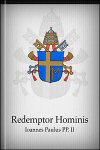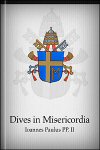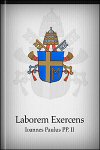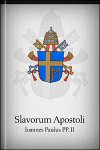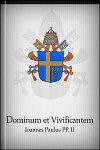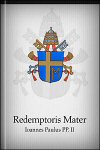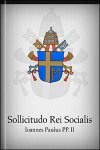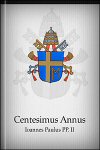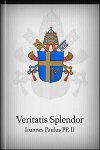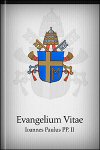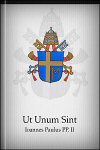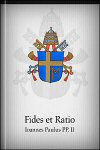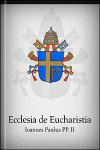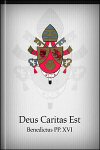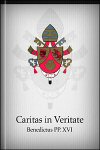Encyclicals of Pope John Paul II and Pope Benedict XVI (34 vols.)
Digital Logos Edition
Overview
For nearly two thousand years, popes have communicated to the world primarily through their letters. In the premodern world, the papal chancery turned out tens of thousands of letters a year. On occasion, a letter dealt with broad concerns and was intended to circulate through the churches of a given region. Such letters became known as encyclicals. In the modern period, papal encyclicals have become the primary medium through which the papacy exercises its teaching office. Through them, the popes address theological topics of especially timely concern, applying Christian doctrine to the immediate circumstances of the day.
Pope John Paul II wrote 14 encyclical letters. In them, the pontiff developed his characteristic personalism—a focus on the dignity of each human person as an end in and of themselves. Through this lens, John Paul II analyzed the problems faced by the contemporary world and provided penetrating insight into their solutions—solutions that focused not on political or economic policy, but on conversion. The topics of his encyclicals varied from the relationship between faith and reason, to guidelines for a just economic order, to contemporary ecumenism.
Pope Benedict XVI has written three encyclicals. He has treated the three theological virtues, faith, hope, and love, in the light of current theological and social problems. His focus has been on love as the most basic reality, and thus as the starting point for his theological analysis. He has also produced a major contribution to social doctrine with his encyclical Caritas in Veritate (Charity in Truth). In this significant body of work, the pontiff has attempted to interpret the teaching of Vatican II in light of recent developments, endeavoring to articulate its authentic doctrine.
As a body of work, Encyclicals of Pope John Paul II and Pope Benedict XVI (34 vols.) offers some of the most important theology produced in recent decades. With the Logos edition, all Scripture passages in the encyclicals are tagged and appear on mouse-over. What's more, references to important works, such as the decrees of Vatican II, Trent, or the writings of the Church Fathers, are tagged. This makes these texts more powerful and easier to access than ever before for scholarly work or personal study. With the advanced search features of Logos Bible Software, you can perform powerful searches by topic or Scripture reference—finding, for example, every mention of “mercy” or “Eucharist.”
Interested in having these in Spanish as well? You can find the Spanish edition here.
- A compilation of all the encyclicals of Pope John Paul II and Pope Benedict XVI
- Latin and English texts can be read side-by-side in your digital library
- Title: Encyclicals of Pope John Paul II and Pope Benedict XVI
- Publisher: Libreria Editrice Vaticana
- Volumes: 34
This title is included in the following collections
You can save when you purchase this product as part of a collection.
Verbum 5 Gold Legacy Library
$849.99$849.99Verbum 8 Platinum Legacy Libra...
$1,499.99$1,499.99Verbum 7 Platinum Legacy Libra...
$1,499.99$1,499.99Verbum 6 Platinum Legacy Libra...
$1,499.99$1,499.99
- $1,499.99
- $1,499.99
- $2,499.99
- $2,999.99
- $2,999.99
- $2,999.99
- $3,999.99
- $4,749.99
- $4,749.99
- $4,749.99
- $7,749.99
- $7,749.99
- $21,749.99
- $24,999.99
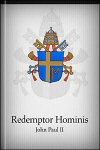
Pope John Paul II promulgated Redemptor Hominis (Redeemer of Man) only five months after his election to the pontifical throne. The encyclical letter provided an outline for the objectives of his pontificate. Rooted in the pope's characteristic "personalism," the letter explores the far-reaching implications of the fact that "the Redeemer of man, Jesus Christ, is the center of the universe and of history." In section one, "Inheritance," the pope expressed the need to continue the work of the Second Vatican Council, especially with regards to ecumenism. In section two, "The Mystery of the Redemption," the Incarnation is placed at the very center of human reality, redeeming the true dignity of humanity and of all creation. In section three, "Redeemed Man and His Situation in the Modern World," the pope expresses that the condition of humanity in the world must be the concern of the Church because of the inherent dignity of man as confirmed in Christ. In the final section, "The Church's Mission and Man's Destiny," the Church is posited as the living reality of man's redeemed vocation, a reality that is most perfect in the Eucharist.

Written in 1980, Dives in Misericordia (Rich in Mercy) was Pope John Paul II's second encyclical. The letter focuses on the mercy of God, an attribute, the pope argues, that is stronger than all evil. What's more, God's mercy does not humiliate man, but rather elevates his dignity. As the manifestation of God's love in the world, mercy is the central message of Christ's preaching. The letter as a whole is an exploration of the role of God the Father's mercy throughout salvation history and within the mystery of redemption. It follows this theme through eight sections: "He Who Sees Me Sees the Father," "The Messianic Message," "The Old Testament," "The Parable of the Prodigal Son," "The Paschal Mystery," "Mercy . . . From Generation to Generation," "The Mercy of God in the Mission of the Church," and "The Prayer of the Church in Our Times."
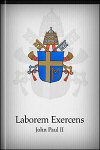
Pope John Paul II wrote Laborem Exercens (Through Work) in 1981 for the ninetieth anniversary of the famous encyclical Rerum Novarum of Leo III on the question of labor in modern economies. Laborem Exercens makes an important contribution to Catholic social doctrine. Rooted in the pontiff's characteristic personalism, the letter seeks to expound a concept of labor that is consistent with the dignity of the human person. This involves the total subordination of all aspects of the economy and production to the worker's status as a human person. It also explores the dignity inherent in labor. The letter has four sections: "Work and Man," "Conflict between Labor and Capital in the Present Phase of History," "Rights of the Workers," and "Elements for a Spirituality of Work."
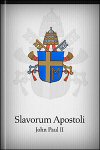
Pope John Paul II wrote Slavorum Apostoli (The Apostles of the Slavs) in 1985. The letter is a commemoration of Saints Cyril and Methodius, the ninth-century apostles to the Slavic nations of Europe. The encyclical, written by the first Slavic pope, focused on the cultural unity of the Slavic nations with the rest of Europe, and is seen to have had two primary objectives: undermine the isolation of the Communist bloc and work toward the unity of the Latin, Greek, and Slavonic branches of Christianity.
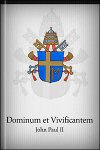
Promulgated in 1986, Dominum et Vivifcantem (The Lord and Giver of Life) focuses on the action of the Holy Spirit in the life of the Church. It is the final letter in Pope John Paul II's treatment of the Trinity, following Redemptor Hominis on the Son and Dives in Misericordia on the Father. In the first section, "The Spirit of the Father and of the Son, Given to the Church," the pope explores the action of the Holy Spirit through the Church in history. The second section, "The Spirit Who Convinces the World Concerning Sin," considers the continuing forgiveness and redemption from sin offered to man through the Holy Spirit. In the third section, "The Spirit Who Gives Life," the pontiff explains that even in the face of the atheistic materialism of modern culture, openness between man and God remains through the work of the Holy Spirit, most perfectly in the Sacraments of the Church. The Holy Spirit is, therefore, the guardian of hope.
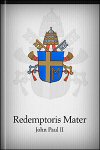
Pope John Paul II promulgated Redemptoris Mater (The Mother of the Redeemer) in 1987. The encyclical is a complex exploration of Mariology. The first section, "Mary in the Mystery of Christ," explains Mary's role in the divine plan of salvation. The second section, "The Mother of God at the Center of the Pilgrim Church," discusses Mary's continuing role as the perfect "mirror" of faith. The pope explains, Mary's journey of faith becomes one with that of the Church at Pentecost. "Thus, from the very first moment, the Church 'looked at' Mary through Jesus, just as she 'looked at' Jesus through Mary." In the third and final section, "Maternal Mediation," the pope explores Mary as Mediatrix, as the intercessor in unity with both her Son and the pilgrim Church. "Thus, throughout her life, the Church maintains with the Mother of God a link which embraces, in the saving mystery, the past, the present, and the future, and venerates her as the spiritual mother of humanity and the advocate of grace."
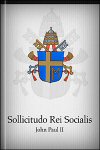
Written in 1987, Sollicitudo Rei Socialis (Solicitude for Social Issues) was John Paul II's second social encyclical. In it, the pontiff elaborates on Catholic social teaching and applies its principles to the problem of under-developed and developing nations. Central to this social teaching is that all aspects of social action must "respect and promote all the dimensions of the human person." The pontiff's essential message is that progress is about more than the accumulation of material goods or social power, and so it supersedes vying economic or ideological systems. Rather, progress is found in justice and the "authentic development" of the human person. After the introduction, section two, "Originality of the Encyclical Populorum Progressio," comments on Pope Paul VI's letter of twenty years prior. Section three "Survey of the Contemporary World," lays out the pope's understanding of the current situation. Section four "Authentic Human Development," explores the meaning of "development" in light of Catholic social teaching. Section five, "A Theological Reading of Modern Problems," applies this teaching to the current situation. Section six, "Some Particular Guidelines," provides a way forward, paying special attention to the Church's "preference for the poor."

Pope John Paul II promulgated Redemptoris Missio (Mission of the Redeemer) in 1990. The encyclical is an urgent call for the Church to renew her commitment to evangelize the world. The letter is divided into two parts. The first part, made up of three sections, "Jesus Christ, The Only Savior," "The Kingdom of God," and "The Holy Spirit: The Principal Agent of Mission," presents a theological defense for the imperative of evangelization. The second part, made up of five sections, "The Vast Horizons of the Mission ad Gentes," "The Paths of Mission," "Leaders and Workers in the Missionary Apostolate," "Cooperation in Missionary Activity," and "Missionary Spirituality," provides guidelines for the application of the theology of mission to the contemporary Church.
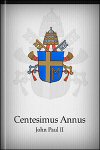
Written in 1991 on the occasion of the 100-year anniversary of Leo XIII's ground-breaking social encyclical Rerum Novarum, John Paul II's Centesimus Annus (The Hundredth Year) brought the principles of Catholic social teaching to bear on contemporaneous political and economic issues. It emphasizes the dignity and rights of workers, the right to private property, the right to a just wage, and the right to religious freedom. It also articulates that the kingdom of God cannot be confused with temporal political or economic arrangements and seeks to explicate the two over-riding principles of the Church's social teaching: solidarity (which focuses on empathy and human dignity), and subsidiarity (the principle that communities of a higher order should not interfere in the life of communities of a lower order unless necessary). The encyclical is made up of six sections: "Characteristics of Rerum Novarum," "Towards the 'New Things' of Today," "The Year 1989," "Private Property and the Universal Destination of Material Goods," "State and Culture," and "Man Is the Way of the Church."
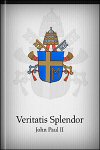
Pope John Paul II promulgated Veritatis Splendor (The Splendor of Truth) in 1993. The letter is one of the most important works of moral theology in the Catholic tradition. At its core the work is a refutation of moral relativism and nihilism. The pontiff asserts that absolute truth does exist and that it is accessible to mankind. Also, the encyclical re-states that the Magisterium of the Church has authority to pronounce definitively on moral issues. Other focuses are the natural law, human freedom, the role of conscience, the reality of evil, and a refutation of the concept of the "fundamental option." The letter is divided into three sections: "Teacher, What Good Must I do . . . ?," "Do Not be Conformed to this World," and "Lest the Cross of Christ be Emptied of Its Power."

Pope John Paul II issued Evangelium Vitae (The Gospel of Life) in 1995. The encyclical states the Church's teaching on the dignity and inviolability of human life. The pontiff asserts that the immorality of murder, abortion, and euthanasia is a teaching of the ordinary and universal Magisterium of the Church and is therefore infallible and unchangeable. He also treats capital punishment, stating it to be normally immoral. The letter also deals with more general issues such as sexual morality, the importance of the family, and society's duty to care for the sick and the poor. The encyclical is divided into four sections, "The Voice of Your Brother's Blood Cries to Me from the Ground: Present-Day Threats to Human Life," "I Came That They May Have Life: The Christian Message Concerning Life," "You Shall Not Kill: God's Holy Law," and "You Did It to Me: For a New Culture of Human Life."
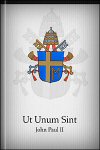
Pope John Paul II wrote Ut Unum Sint (That They Might Be One) in 1995. The encyclical focuses on the Roman Catholic Church's relationship with the Orthodox Churches and with other Christian ecclesial communities and expresses the Church's commitment to an ecumenism that does not dilute the importance of doctrine. The letter is divided into three sections: "The Catholic Church's Commitment to Ecumenism," "The Fruits of Dialogue," and "Quanta est Nobis Via?."
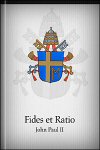
Written in 1998, Fides et Ratio (Faith and Reason) is Pope John Paul II's treatment of the relationship between faith and reason. The pope re-iterates the Church's teaching that faith and reason are not only not in conflict, but are in their essences bound up together. Faith without reason tends toward superstition and reason without faith tends toward nihilism. The pope calls for their re-integration and defends the Church's responsibility to intervene in philosophy when its errors threaten revelation. The letter is divided into seven sections: "The Revelation of God's Wisdom," "Credo ut Intellegam," "The Relationship between Faith and Reason," "The Magisterium's Interventions in Philosophical Matters," "The Interaction between Philosophy and Theology," and "Current Requirements and Tasks."
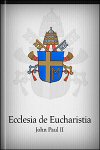
Ecclesia de Eucharistia (Church of the Eucharist) was promulgated by Pope John Paul II in 2003. The encyclical focuses on the Eucharist as the "source and the summit" of Christian life and as the most precious possession of the Church. The pope calls for a renewal of Eucharistic devotion, asserts the sacrificial character of the Mass, and re-iterates the necessity of the ministerial priesthood and the reality of apostolic succession. The letter is divided into six sections: "The Mystery of Faith," "The Eucharist Builds the Church," "The Apostolicity of the Eucharist and the Church," "The Eucharist and Ecclesial Communion," "The Dignity of the Eucharistic Celebration," and "At the School of Mary, 'Woman of the Eucharist.'"
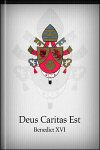
Written in 2005, Deus Caritas Est (God is Love) was Pope Benedict XVI's first encyclical letter. It focuses on Love as the central reality of existence. The letter explores the concept of love at a theological and philosophical level, discussing eros, agape, and philia. It also articulates how love should become manifest in the life of the Church, through the proclamation of the word of God, the celebration of the Sacraments, and the exercise of charity. The encyclical is divided into two sections: "The Unity of Love in Creation and in Salvation History," and "Caritas: The Practice of Love by the Church as a 'Community of Love.'"

Pope Benedict XVI promulgated Spe Salvi (Saved by Hope) in 2007. The encyclical is a exploration of the theological virtue of hope and its relationship to redemption. The pontiff explains that the hope offered by Christ is not that of political liberation or economic abundance, but is rather of an encounter with the living God that surpasses all socio-political considerations. The letter is divided into eight sections: "Faith is Hope," "The Concept of Faith-Based Hope in the New Testament and the Early Church," "Eternal Life—What Is It?," "Is Christian Hope Individualistic?," "The Transformation of Christian Faith-Hope in the Modern Age," "The True Shape of Christian Hope," "'Settings' for Learning and Practicing Hope," and "Mary, Star of Hope."
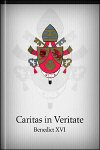
Published in 2009, Caritas in Veritate (Charity in Truth) was pope Benedict XVI's first social encyclical. The encyclical is concerned with many aspects of global development and economic and political justice. The pontiff aims to lay down moral guidelines within which specific policies can be crafted. These guidelines include a rejection of both socialist and free-market ideologies in favor of a conception within which all social actions are informed by ethics. The letter discusses poverty, population issues, the environment, relativism, sexual exploitation, and many other timely issues. It is divided into six sections: "The Message of 'Populorum Progressio,'" "Human Development in Our Time," "Fraternity, Economic Development and Civil Society," "The Development of People, Rights and Duties, and the Environment," "The Cooperation of the Human Family," and "The Development of Peoples and Technology."
John Paul II (Karol Józef Wojtyla) (1920–2005) served as Pope for 26 years (1978–2005). In 1942, he felt called to the priesthood and began courses in the clandestine seminary of Krakow. Wojtyla was ordained to the priesthood on November 1, 1946, and shortly after, was sent to Rome where he worked under Garrigou-Lagrange. In 1958 he was appointed as the titular bishop of Ombi and auxiliary of Krakow and in 1964 was appointed as the archbishop or Krakow. Three years later, he was elevated to Cardinal.
In 1978, Karol Wojtyla was elected Pope, where he took on the name John Paul II. As Pope, he was instrumental in ending communism in his native Poland. He significantly improved the Catholic Church's relationship with Judaism, Islam, the Eastern Orthodox Church, and the Anglican Communion. He has been acclaimed as one of the most influential leaders of the twentieth century.
Pope Benedict XVI (Joseph Ratzinger), was born on 16 April 1927 in Marktl, Bavaria in Germany. During his youth, his father's devout Catholicism led to conflicts with the Nazi regime, and his family was forced to relocate several times. At the age of twelve he enrolled in minor seminary, but the seminary was closed for military use in 1942. He resumed his studies for the priesthood in 1946 and was ordained a priest on June 29, 1951. A year later he began teaching at the Higher School of Freising. He received his doctorate in 1953 and became a professor at Freising College in 1958.
On March 25, 1977, Pope Paul VI named him Archbishop of Munich and Freising, and on June 27 of that same year he was made a Cardinal. In November 1981, he was summoned by Pope John Paul II to Rome, where he was named Prefect of the Congregation for the Doctrine of the Faith, President of the Pontifical Biblical Commission, and President of the International Theological Commission.
On April 19, 2005, Cardinal Joseph Ratzinger was elected to be the 265th pope. He took the name Benedict XVI, after St. Benedict of Nursia. As pope, he received worldwide respect and was a spiritual influence to Christians and non-Christians alike. In 2013, he resigned the papacy, becoming the first pope to do so in since the fifteenth century. He retired to a monastery in the Vatican Gardens, where he continues to study and write.
Reviews
7 ratings

Fr. Jered A. Grossman
4/15/2015
What more do you need to say. These are the encyclicals of Saint Pope John Paul II and Pope Emeritus Benedict XVI.
Corey Spiegel
2/21/2015

Faithlife User
9/12/2014

Sr. Julie Marie Benedicta
10/3/2013

Anthony Measures
9/27/2013
Michael Maria Waldstein
8/25/2013

Joel Landon Watts
2/13/2013
These letters show how the two popes covering most of our lifetimes have develop Catholic doctrine and practical theology in the face of post-modernism, the rise of the vitriolic class, the end of Communism, and all the while exploring what Vatican II means to twentieth and twenty-first century Catholics (and Christians on the whole, if we allows ourselves to willingly found common ground).
